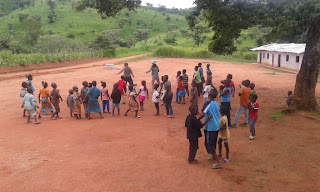Mandetkene Boutique: Chapter 3, getting to know you
Beyond watching the construction of the store, we wanted to
do more in the town to build trust and raise awareness about the purpose of the
store. We decided to go door-to-door to survey residents about what they’d like
to see in the store. We also decided to do a summer camp, as Amirah and Jenna
had done this two summers ago and it worked well. The following recounts these
two endeavors.
Endeavor #1: Door-to-Door,
getting to know people and concerns
I think you can really get to know a person by learning what
they buy. The short time we spent going door-to-door in Mandetkene, asking
people a set of carefully thought out questions, was the time in which I
learned the most about the local people. I could tell you which brand of soap
they like, what type of oil they use when cooking, and the types of treats they
like.
We had a different experience in every house we visited. However,
after organizing survey responses in excel, we found many common needs and
picked out the popular items. One elderly man noted the importance of razor
blades, while a few younger women asked for hair braiding string. Everyone
wanted rice and peanut and palm oil
The excitement was palpable in most households, and this was
rewarding. Above all, we wanted the community to take ownership of the store so
it could truly meet their needs. We hoped our canvassing would aid this. It
allowed us to address concerns and make adaptations to the store plans. For
example, a few people were apprehensive about inevitable higher prices, so we
did our best to quell the unease by collecting data on the cost of traveling to
the shops in Foumban and calculating how much one could save even with slightly
higher prices. We also got to add requested items to the inventory list. In the
end, I think our door-to-door strategy served its purpose and helped make the
opening a success.
Endeavor #2: Summer
Camp Round Two
The way the camp worked was pretty funny. Rather than having
a set time when we’d all meet at the school to begin, we would drive the town
road daily, honking the horn and yelling for kids to come. A herd of children
trailed the car to the school’s doorstep, where the camp would then begin. As
it turned out, not having a set starting time was a huge benefit, as one day we
got a flat tire on the way and arrived two hours late!
We would always start with stretching and dancing, and this
led us to notice one thing in particular—these kids were shy! We noticed this in
other aspects of the camp too. The village kids would always sit quietly,
content to wait. This was in stark contrast to the kids we worked with in
Foumban! There, the kids were anything but quiet and still. As Amirah pointed
out, she thinks it’s the difference between city kids and village kids. We
haven’t been around long enough to really know, but it was wild how different
this camp was from the first.
The camp in Mandetkene was not as topic-specific as the
engineering one in Foumban. We did have a loose music-theme running throughout
the camp, but we also did a variety of non-music activities to give the kids a
glimpse of things they might not see or learn about every day. For example, we
made books and baked a cake (most people don’t have ovens in their homes—they
cook with either gas burners or open fires).
These were fun, but for me, the music was my favorite part. It
was the one consistent thing we did (other than stretching and dancing!). Music has been a large part of my life. I’ve
taken lessons or had music classes since first grade (though I’m not a music
major!), and this camp allowed us to use music to connect with local kids and
build trust with the community, and it also gave us a tool to teach these kids
a little bit of English.
 |
| Daily dancing and stretching |
Every day we worked on learning very basic solfège
(do-re-mi). We looked at very basic musical notation—the staff, how notes
look—and we practiced the camp song: “Do-Re-Mi” from The Sound of Music. Whenever we practiced the song, we would also
practice learning what the English words meant.
 |
| Learning about do-re-mi |
One day we made instruments out of locally available
materials—calabashes, balloons, rubberbands, tape, nails, pebbles. Kids made
drums, maracas, and little stringed instruments. We then improvised with the
instruments and added them to the song we were learning!
 |
| Drums in progress |
 |
| Stringed instruments and maracas in progress |
At first, it was hard to get these shy kids to sing! But
after a little while, they warmed up to us and sang. Here is a video of these
super cute kids-- they are practicing here. Sorry, we forgot to take a video of the finale!

Comments
Post a Comment